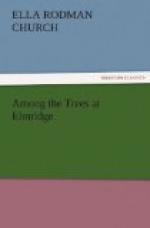“The next thing to be done to the pieces of bark is partially to burn, or char, them, and also to make them quite flat, as they come from the trunk in a rounded shape. The burning makes the pores close up, so that the liquid in a vessel for which it is used as a stopper cannot come through; and this is done over a brisk fire, in what is called a burning-yard. Another process, called rounding, removes every trace of the fire, unless the cork has been too much burned, and then, having already been flattened by the pressure of heavy stones, it is ready for the cork-maker, who cuts the material first into strips and then into squares according to the size of corks wanted.
“Cork is very light and elastic, and can be used successfully in contrivances for the rescue of men from the perils of the deep. The cork jacket and the lifeboat have been the means of saving many lives, for cork will float on the surface of the water and bear up the person wearing the jacket and the shipwrecked people in the lifeboat. ’The shallowness of the boat and the bulk of cork within allow but little room for water; so that even when filled it is in no danger of overturning or sinking, like other crafts. Also, the lifeboat can move across the waves with perfect safety, and can make its way from one object to another in a broken sea as easily as an ordinary boat can pass from one ship to another.’”
The children declared that the cork-oak was the best tree of all, but they agreed with their governess that the entire oak family was made up of grand and useful trees.
“Our American oaks,” said Miss Harson, “are very handsome in autumn because of their brilliant foliage; the scarlet oak, which turns to a deep crimson and keeps its leaves longer than any of the other forest trees, is the most showy of the species. But we have no cork oaks, and no oaks that we know to be a thousand years old. There was once a famous oak in this country, called the ‘Charter Oak,’ which fell to the ground in August, 1856, before any of us were born. I wonder if you would like to hear the story about it?”
This question was thought extremely funny by three such devourers of stories as the little Kyles, and they eagerly assured their governess that they would like it.
“If that is really the case,” continued Miss Harson, smiling at the excited faces, “I must tell you the history of
“THE CHARTER OAK.
“This tree grew in Hartford, Connecticut, and it is said that before the English governor Wyllis went there to live his steward, whom he had sent on before to get a house ready for him, came near cutting down this very oak. He was clearing away the trees around it on the hillside when a party of Indians appeared and begged him to leave that particular tree, because, they said, ’it had been the guide of their ancestors for centuries.’ So the oak was spared; even then it was old and hollow.




